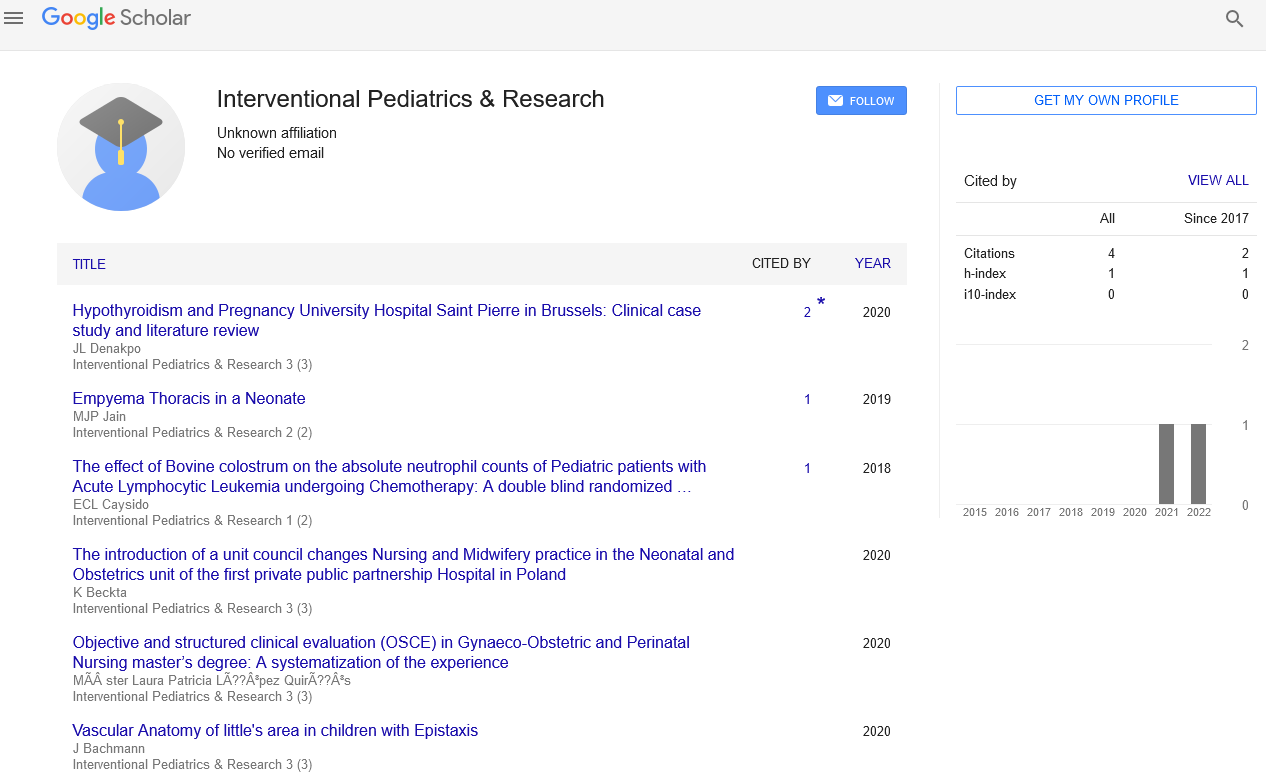Editorial - Interventional Pediatrics & Research (2023) Volume 6, Issue 3
Unraveling Early Repolarization: Recognizing Symptoms and Their Implications
Mehek Ghosh*
Department of Anesthesiology & Critical Care Medicine, Memorial Sloan Kettering Cancer Center, USA
- *Corresponding Author:
- Mehek Ghosh
Department of Anesthesiology & Critical Care Medicine, Memorial Sloan Kettering Cancer Center, USA
E-mail: Mehekghosh3@gmail.com
Abstract
Early Repolarization Syndrome (ERS) is an electrocardiographic finding characterized by specific patterns on the surface electrocardiogram (ECG). It is commonly observed in asymptomatic individuals but can also be associated with adverse cardiac events such as ventricular fibrillation and sudden cardiac death. This abstract aims to summarize the symptoms and clinical presentations associated with early repolarization, highlighting the importance of recognizing this condition for appropriate risk stratification and management.ERS is characterized by J-point elevation and ST-segment elevation on the ECG, typically seen in the inferior and/or lateral leads. Although frequently observed in healthy individuals, it can also manifest in patients with a history of cardiac symptoms, palpitations, or syncope. Furthermore, the ECG findings of early repolarization may be incidentally detected during routine health check-ups or investigations for unrelated complaints. Symptoms associated with ERS can vary widely, ranging from no symptoms at all to severe cardiac events. The most common presenting symptom in individuals with early repolarization is chest pain or discomfort. This pain is usually described as non-exceptional, transient, and unrelated to physical activity. Palpitations, dizziness, and syncope can also occur, especially in individuals with significant J-point elevation and dynamic ST-segment changes. It is crucial to differentiate between benign early repolarization patterns and those associated with an increased risk of arrhythmias and adverse cardiac events. The presence of certain ECG features such as excessive J-point elevation, horizontal or downsloping ST-segment, and QRS slurring (known as “fishhook pattern”) can help identify individuals at higher risk. Additionally, certain high-risk factors such as a family history of sudden cardiac death, prior arrhythmias, or unexplained syncope may warrant further evaluation and consideration for specialized testing or referral to a cardiologist.In early repolarization syndrome is a common ECG finding that may or may not be associated with symptoms. Recognition of symptoms associated with early repolarization is essential for appropriate risk stratification and management. While the majority of individuals with early repolarization have a benign course, identification of high-risk features and consideration of individual risk factors are crucial to prevent potential life-threatening cardiac events. Further research is needed to better understand the underlying mechanisms and establish evidence-based management strategies for individuals with early repolarization syndrome
Keywords
Early Repolarization Syndrome • Electrocardiographic
Introduction
Early repolarization (ER) is a cardiac electrocardiographic (ECG) pattern characterized by specific changes in the ST segment and T wave. It is a common finding in routine ECGs, affecting approximately 1-13% of the general population. Although early repolarization is often considered a benign condition, recent studies have shed light on its potential association with adverse cardiac events [1]. Recognizing the symptoms associated with early repolarization is crucial
for appropriate evaluation and management. In this article, we explore the symptoms associated with early repolarization and their implications.
Understanding early repolarization
Early repolarization is characterized by Early repolarization is characterized by elevation or slurring of the J point (the junction between the QRS complex and the ST segment) in multiple leads of the ECG. It is commonly seen in the lateral and inferior leads, such as leads I, II, V4-V6. The ST segment elevation can manifest as a “fishhook” or “saddleback” appearance. It is important to note that early repolarization is typically seen in young individuals, more commonly in males, and athletes [2, 3]. Symptoms Associated with early repolarization Asymptomatic presentation: In the majority of cases, early repolarization is asymptomatic and is incidentally detected during routine ECG screening or diagnostic tests for other conditions [4]. The absence of symptoms, along with a low-risk profile, contributes to the generally benign nature of the condition.
Chest pain
Some individuals with early repolarization may experience chest pain or discomfort. The pain is usually localized to the left side of the chest and is described as sharp or stabbing. However, it is important to note that chest pain associated with early repolarization is typically brief, lasting for seconds to minutes, and is not accompanied by other high-risk features such as radiation to the arm, jaw, or associated shortness of breath [5].
Palpitations
Palpitations, which are sensations of rapid or irregular heartbeats, may be experienced by individuals with early repolarization. These palpitations can be intermittent and may be associated with increased physical activity or emotional stress [6].
Syncope
While rare, some individuals with early repolarization may experience syncope, which refers to a sudden loss of consciousness. Syncope may occur due to abnormal electrical activity in the heart, although the exact mechanism is not well understood. It is important to note that syncope in the setting of early repolarization should prompt further evaluation to rule out other underlying causes [7].
Implications and management
The clinical significance of early repolarization remains a topic of ongoing research and debate. Most cases of early repolarization are considered benign, especially in individuals without symptoms or risk factors for cardiovascular disease. However, recent studies have suggested a potential association between early repolarization and an increased risk of arrhythmias and sudden cardiac death, particularly in certain high-risk populations [8].
When evaluating individuals with early repolarization, it is crucial to consider their clinical presentation, including symptoms and risk factors. Additional tests such as exercise stress testing, Holter monitoring, and echocardiography may be recommended in selected cases to further assess the individual’s cardiac health and risk profile [9, 10].
Conclusion
Early repolarization is a common ECG finding that is mostly benign and asymptomatic. However, some individuals may experience chest pain, palpitations, or syncope. While the clinical significance of early repolarization remains a topic of ongoing research, a thorough evaluation is necessary to rule out other cardiac conditions and identify individuals who may require further investigation or intervention. Physicians should consider individual risk factors and symptoms in order to provide appropriate management and ensure the
References
- Dolk H, Leke A Z, Whitfield P et al. Global birth defects app: An innovative tool for describing and coding congenital anomalies at birth in low resource settings. Birth Defects Res. 113, 1057-1073(2021).
- Howard L, Mancuso AC, Ryan GL. Müllerian aplasia with severe hematometra: A case report of diagnosis and management in a low resource setting.J Podiatry Adolesc Gyneco. l32, 189-192(2019).
- Jomaa M. A challenging diagnosis and management of Herlyn-Werner-Wunderlich syndrome in low-resource settings: a case report complicated with hydronephrosis. Ann Med Surg. 70,102-843(2021).
- Persani L. Central hypothyroidism: pathogenic, diagnostic, and therapeutic challenges. J Clin Endocr. 97, 3068-3078(2012).
- Dimopoulos G. Cardiovascular complications of down syndrome: scoping review and expert consensus. Circulation. 147, 425-441(2023).
- Timothy E. Obstetric ultrasound use in low and middle income countries: a narrative review. Reprod health .15, 1-26(2018).
- Ballantyne A, Newson A, Luna F et al. Prenatal diagnosis and abortion for congenital abnormalities: is it ethical to provide one without the other?. AJOB.9, 48-56 (2009).
- Melamed N.k FIGO (international Federation of Gynecology and obstetrics) initiative on fetal growth: best pracice advice for screening, diagnosis, and management of fetal growth restriction. Int J Gynaecol Obstet. 1,152 -352(2021).
- Bello AL, Acquah A, Quartey JN et al. Knowledge of pregnant women about birth defects. BMC Pregnancy and Childbirth. 13, 1471-2393(2013).
- Mbonda A. Diagnosis of Fraser syndrome missed out until the age of six months old in a low-resource setting: a case report. BMC paediatrics. 19, (2019).
Indexed at, Google Scholar, Crossref
Indexed at, Google Scholar, Crossref
Indexed at, Google Scholar, Crossref
Indexed at, Google Scholar, Crossref
Indexed at, Google Scholar, Crossref
Indexed at, Google Scholar, Crossref
Indexed at, Google Scholar, Crossref
Indexed at, Google Scholar, Crossref
Indexed at, Google Scholar, Crossref


